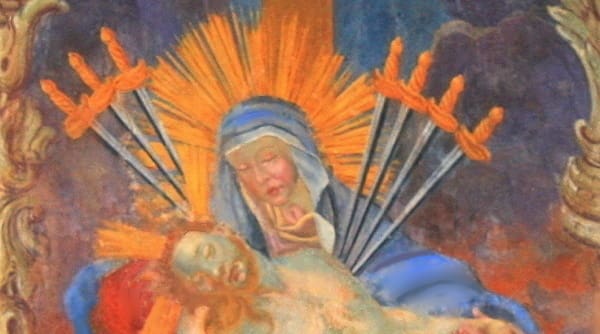Love gives new life to the heart. By its nature, the heart lives for itself; when it is struck by love, it begins a new life for the one it loves. So the Blessed Virgin lived by the strength of her love. Her condition was one of mortal sorrow, a crucifying sorrow, and, amid this sorrow, she lived by love. She always kept before her eyes Jesus Christ crucified. For the efficacy of faith is such that, if St. Paul was able to say to the Galatians that Jesus was crucified before their eyes (Gal. 3:1), how much more was the Blessed Virgin able to remain in the presence of her Son, cruelly torn, bleeding, and dying from his many wounds.
Being always mindful of the Cross and the sufferings of Jesus, she led a life of sorrow and death and was able to say with the apostle, “I die every day” (1 Cor. 15:31). But love came to her aid and supported her in her grief. A vigorous desire to conform herself to the will of her beloved made her grief bearable, and Jesus alone lived in her, because she lived only for his love.
The martyrs were animated by a desire to suffer that spurred their courage, upheld their strength, and at the same time prolonged their lives. In order to be conformed to the crucified life of Jesus, Mary always kept Jesus crucified before her eyes; she lived a life of sorrow, and her love made that sorrow bearable because of her desire to be conformed to Jesus, to be pierced by his nails, to be attached to his Cross.
Mary lived only to suffer: “Sustain me with raisins, refresh me with apples; for I am sick with love” (Song of Sol. 2:5). Her love, always languishing because of her sorrow, sought support. What support? The raisins of Calvary and the apples of the Cross. The raisins of Calvary are the thorns; the apples of Calvary are the pain Jesus bore. This is the support that the languishing love of Mary sought. The love of Jesus crucified made her live in this life: in her eyes she saw Jesus crucified, and by her ears she heard the last cry of her beloved as he expired, a terrible cry that rent her heart.
This love also makes us live for souls. By her interior suffering, Mary fulfilled “what is lacking in Christ’s afflictions” (Col. 1:24). It seems that he wanted to leave her in the world after him in order to console his Church, his widowed and desolate Spouse. “The voice of the turtledove is heard . . . turn, my beloved” (Song of Sol. 2:12, 17). This is the cry of the Church, who calls out for the dear spouse she had possessed for a mere moment.
O the cruel one, she cries, O the pitiless one! For how many centuries did we wait for him, and with how much desire! The synagogue did not see him, but the Church saw him, heard him, and touched him, and then, all at once, he left her. O the cruelty! She says to him, with St. Peter, “[W]e have left everything and followed you” (Matt. 19:27). Yet he married her, taking her poverty and detachment for his dowry. And just as soon as he married her, he died, and if he rose from the dead, it was to return whence he came, and he left his chaste Spouse upon the earth, a young and desolate widow.
Mary was given as the unique consolation of all the faithful on earth. She sees her son in all his members. Her compassion is a prayer for all who suffer. Her heart is in the heart of all who weep, to help them to cry for mercy; in the wounds of all the injured, to help them cry for help; in every charitable heart, to press it to lend assistance and consolation to those who need it; in every apostle, to announce the Gospel; in every martyr, that he may be sealed with blood; and, finally, in the hearts of all the faithful, that they may observe what they are commanded, profit from counsel, and imitate good examples.
The support for this condition of ours is Holy Communion. “With great delight I sat in his shadow, and his fruit was sweet to my taste” (Song of Sol. 2:3). St. Bernard explained:
His fruit is his body, and his shadow is faith. Mary sat in the shadow of her own Son, while we sit in the shadow of our faith in the Lord. Why should his fruit not delight us, since we eat it in the holy mysteries? The spouse desires to be covered by the shadow of the one from whom she is to receive refreshment and nourishment. The other trees of the forest may console by their shade, but they do not give any nourishment and they do not produce the fruit of salvation. One alone, the author of life, is able to say to his spouse, I am your salvation. And so she desires to sit in the shadow of Christ, because he alone not only refreshes us by protecting us from the heat of vice, but fills our hearts with the love of virtue.
Since we cannot enjoy the light itself, let us at least rest ourselves in the shade, but let us seek out a tree that can give us not only shade, but also fruit, and not only refreshment, but also nourishment. Only one can do so: Jesus Christ in Holy Communion. Let us then rest our love — languishing and fading for want of possessing the truth — under his shade. He is our only support.
+
This article is an excerpt from Meditations on Mary by Bishop Jacques-Bénigne Bossuet, which is available from Sophia Institute Press.
Art for this post on Our Mother of sorrow and love: Partially restored detail of Farm (Plant) [Building] in Einhof, Germany, artist unknown, photographed by Jürgele, 13 October 2012, Wikimedia Commons. Cover of Meditations on Mary used with permission.
To read more about Our Lady of Sorrows, click HERE.





